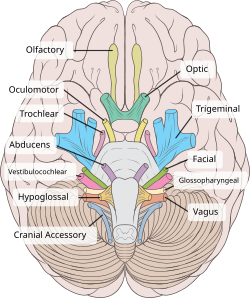Auditory vestibular nerve
| Vestibulocochlear nerve | |
|---|---|

The course and connections of the facial nerve in the temporal bone
|
|

Inferior view of the human brain, with the cranial nerves labelled.
|
|
| Details | |
| To | Cochlear nerve, vestibular nerve |
| Identifiers | |
| Latin | Nervus vestibulocochlearis |
| MeSH | A08.800.800.120.910 |
| TA | A14.2.01.121 |
| FMA | 50869 |
|
Anatomical terms of neuroanatomy
[]
|
|
The vestibulocochlear nerve (auditory vestibular nerve), known as the eighth cranial nerve, transmits sound and equilibrium (balance) information from the inner ear to the brain.
The vestibulocochlear nerve consists mostly of bipolar neurons and splits into two large divisions: the cochlear nerve and the vestibular nerve.
Cranial nerve 8, the vestibulocochlear nerve, goes to the middle portion of the brainstem called the pons, (which then is largely composed of fibers going to the cerebellum). The 8th cranial nerve runs between the base of the pons (the middle portion of the brainstem and medulla oblongata (the lower portion of the brainstem). This junction between the pons, medulla, and cerebellum that contains the 8th nerve is called the cerebellopontine angle. The vestibulocochlear nerve is accompanied by the labyrinthine artery, which usually branches off from the anterior inferior cerebellar artery (AICA) at the cerebellopontine angle, and then goes with the 8th nerve through the internal acoustic meatus to the internal ear.
The cochlear nerve travels away from the cochlea of the inner ear where it starts as the spiral ganglia. Processes from the organ of Corti conduct afferent transmission to the spiral ganglia. It is the inner hair cells of the organ of Corti that are responsible for activation of afferent receptors in response to pressure waves reaching the basilar membrane through the transduction of sound. The exact mechanism by which sound is transmitted by the neurons of the cochlear nerve is uncertain; the two competing theories are place theory and temporal theory.
...
Wikipedia
